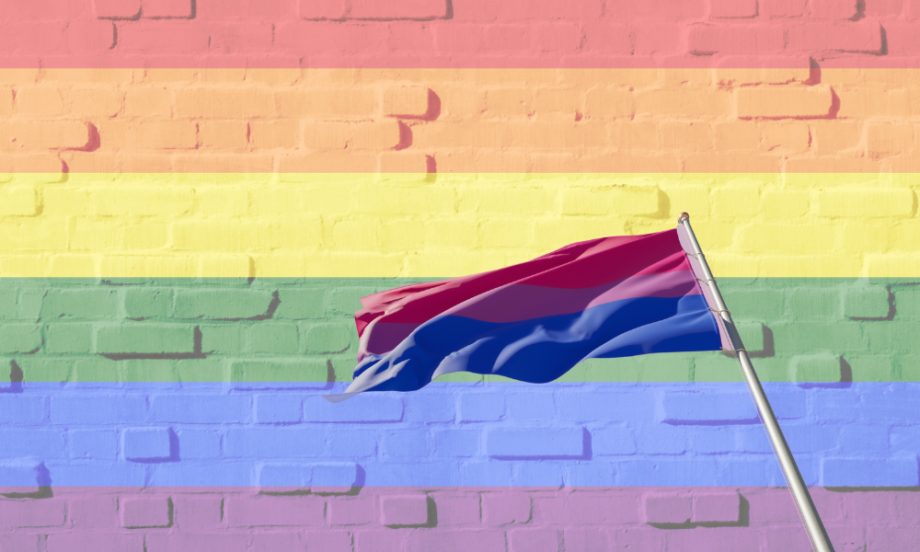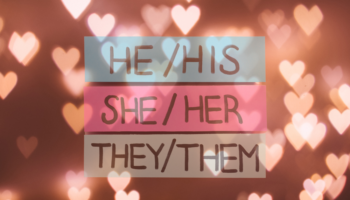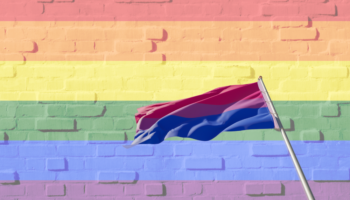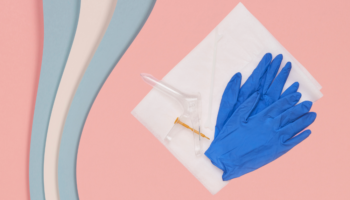My queer sexual awakening started the same way that it does for many queer folks – with the realization that I wanted my best friend to be more than my friend. But every time these feelings stirred in me, they were immediately followed by shame and confusion. My boyfriend and I had been together for almost two years at that point, and I really did love him. And I was really attracted to him. And we had great sex. So, why did I have these feelings? And what did they mean about my sexuality?
The setting of my personal teenage drama was a small, somewhat rural town in the early 2000s, so my queer education came entirely from TV and movies. Willow and Tara in "Buffy the Vampire Slayer" and the respectable gays of "Will & Grace," Megan and Graham in "But I’m a Cheerleader." Consequently, my queer education was binary: gay men and lesbian women.
My friends and I had a passing knowledge of bisexuality, but as we understood it then, bisexual meant girls who kissed other girls when they were drunk or that one gay guy we knew who sometimes hooked up with this girl we knew. We saw bisexuality as experimentation, not an actual sexual orientation.
We saw bisexuality as experimentation, not an actual sexual orientation.
So, as I grappled with my love for my boyfriend and his penis and my growing attraction to my best friend, it never occurred to me that I might be bisexual. I felt inextricably trapped between straight and lesbian, truly believing I had to be one or the other, and at the same time, knowing that neither fit.
Eventually, I told my boyfriend about these feelings. He said he didn’t want to stop me from exploring who I was. So, I fell in love with another one of my best friends, dated her, and started drama worthy of "The L Word." In the end, even though I loved that girlfriend, I chose the boyfriend.
And with that choice, I thought I chose being straight. I married that high school boyfriend, blew up that marriage, and jumped right into a relationship with another guy.
Then, I befriended a lesbian couple who reintroduced me to queer life, and the more time I spent around queer folks, the harder it was to deny the fact that I was really attracted to women.
Read: The Best Lesbian Sex Positions, According to Lesbians
A year or so into our friendship, one half of that lesbian couple sat me down and literally said, “You’re not straight. I spent years pretending to be straight and being miserable. I don’t want you to go through that. So, please just believe me. You’re not straight.”
I knew she was right. I definitely wasn’t straight. But I wasn’t a lesbian either. I wasn’t pretending to be attracted to men; I was attracted to men. I wasn’t pretending to love penis; I really loved it. But she was right. I wasn’t straight. So, I broke up with my boyfriend about a week later, told everyone I knew I was a lesbian after all, and set out to slut my way through the local queer community.
Yes, early 20s me was the definition of disaster gay. I was young and jaded, drinking constantly and doing whatever drugs people were willing to give me, towing around a boatload of untreated mental illness and trauma, and so confused about who I was. Those aren’t excuses for the fact that I hurt a lot of people during that time; they’re just context and the truth.
Eventually, I hit bottom, got sober, and stayed single and celibate for a year while I put my life back together. During that year, I thought about sex, a lot, and I couldn’t ignore the fact that the pornos playing out in my sex-starved brain featured women and men, even though I’d been identifying as a lesbian for almost two years.
When I was finally ready to date again, I decided to go out with a few guys, just to see what happened. I ended up going on several dates with one guy and caught big feelings.
When I told my friends about this guy, many of my queer friends distanced themselves. Some of them just implied that I wasn’t queer anymore, while others outright told me I wasn’t. I was a pretender, a hasbian who had chosen the safe, straight life.
Though the rejection was devastating, it gave me the clarity I’d been searching for since high school. I knew they were wrong. I knew that my queerness had nothing to do with who I was dating; it was an inextricable part of who I was.
In an attempt to explain this feeling to myself, I began reexamining bisexuality. Luckily, there was a lot more information about bisexuality available than when I was in high school and a lot more discourse about bi erasure within the queer community. I saw so much of myself reflected in bisexual people’s stories. So, when I said, “I’m bisexual” at 24 years old, I knew I’d finally found where I fit.
Until I heard the word pansexual. In my annual post on my blog in 2019, I mentioned that I was questioning whether bisexual was inclusive enough for me. I didn’t think my attraction was limited to people within the gender binary, and since bisexual was an attraction to just two genders – men and women – I didn’t know if it fit me anymore.
Read: Celebrate Bisexuality Day
My post sparked a massive comments section debate about the distinctions between pansexual and bisexual. My bisexual friends clarified that, regardless of the prefix, bisexual means attraction to the same gender and any other gender(s). One asserted that the existence of the term pansexual was basically bi erasure and that people who identified as pansexual were “problematic.” Others fired back, insisting that pansexual was more inclusive than bisexual because it encompasses attraction to people of all genders. Some accused bisexual folks of transphobia because they weren’t attracted to people of all genders. To be honest, I was so overwhelmed that I checked out of the conversation.
At the time, I didn’t know that my friends were having the same heated debate queer folks all over the internet had been having for years. As Heckin Unicorn lays out in their amazingly comprehensive breakdown of the debate over the two identifiers, the internet drama between bisexuals and pansexuals reached a peak in the mid 2010s, when high-profile celebs like Miley Cyrus and Janelle Monae publicly identified as pan. Of course, their coming outs didn’t start the drama. It had been simmering in online queer communities for a while, sparked by the evolving conversation about making queer communities more gender inclusive.
When I started to dig further into the pan versus bi debate, I found that the majority of the discourse boiled down to a few assertions:
- Bisexual and pansexual are the same thing, so we don’t need both labels
- Bisexual isn’t gender inclusive
- Pansexual was created to as a more gender-inclusive version of bisexual.
The funny thing is, even the most basic Google searches revealed that none of these assertions is true.
Although bisexuality and pansexuality are similar, there are subtle but very important differences. Ambassadors for LGBTQ+ youth charity Just Like Us, told Gay Times that bisexual encompasses anyone who is attracted to people of their own gender and at least one other gender, so it’s actually an umbrella term that encompasses pansexual. The big difference between bisexual and pansexual is the role that gender plays in romantic and/or sexual attraction.
Gender doesn’t really factor into pansexual people’s attraction. They’re attracted to people regardless of gender. For bisexual folks, gender still plays a role in their romantic and/or sexual attraction. They’re attracted to people of two or more genders, which could be men and women or men, women, and non-binary folks, or men, women, and agender folks… the list could go on and on. There are so many different ways to be bisexual, including being pansexual!
It’s also important to understand that pansexual was not created in response to the word bisexual not being inclusive enough, and it’s not a more inclusive “version” of bisexuality. The word pansexual was actually coined in the early 1900s as a psychoanalytical term used to criticize Sigmund Freud’s theory that all human behavior is driven by sex, Them explains. Pansexual wasn’t commonly used as a label for sexuality until the late 1970s and early 1980s, but even then, it didn’t gain popularity because bisexual wasn’t inclusive enough. People took on the label to communicate the fact that they were open to experiences with all kinds of people, not just people of certain genders.
In the 1990s, many people started identifying as pansexual to clearly communicate to others in the queer community that they were attracted to trans, non-binary, and agender folks as well as cis folks. Around the same time, the Bay Area Bisexual Network published The Bisexual Manifesto, which sought to dispel myths about bisexuality. The very first myth busted in the manifesto is the myth that bisexuality is binary, limited to two genders, or implies the existence of only two genders. The Bisexual Manifesto, which many bisexual folks still refer to as the “Bisexual Bible,” is unequivocal about bisexuality’s inclusiveness and fluidity, as well as the fact that bisexual means something different to each person who identifies as bisexual.
To sum it up, bisexual and pansexual have both existed as their own sexual identities for decades; they’ve never really been at odds with each other at all.
Why do we need pansexual, omnisexual, polysexual, ambisexual and so many other labels that fall under the bisexual umbrella? Because queer folks are so painfully familiar with describing ourselves with words that don’t quite fit because we don’t know that there’s a word for who we are. Using an imprecise word for our identity may also be easier than using a word that actually fits. Having separate words gives queer folks that moment when we get to say “Oh that’s me. This is where I belong.” It allows us to describe ourselves with words that actually fit.
Having separate words gives queer folks that moment when we get to say “Oh that’s me. This is where I belong.”
The word bisexual gave me permission to stop seeing myself as either straight or gay, depending on who I was dating or hooking up with. The word non-binary liberated me from the gender binary that I’d always felt trapped by. The word transmasculine informed me that being masculine is separate from being a man, which allowed me to embody masculinity without having to identify as a man.
Before I had those words, the feeling that I didn’t quite fit anywhere hovered around me like a fog only I could see. Without each of these words, I’d still be trapped in the illusion of being a sometimes straight, sometimes lesbian cis woman, and that’s not me at all. I am a bisexual, non-binary, transmasculine person, and I finally know where I fit.
Robin Zabiegalski (they/them) is a queer, non-binary writer, editor, and movement instructor. They've been writing for Kinkly since 2017, and joined Kinkly's Editorial Team in early 2024. Their writing has also been published on xoJane, Heavy.com, Health Digest, Glam, Women.com, The Establishment, Sexual Being, The Tempest, and several other digital media publications. When Robin isn't writing they can be found practicing or teaching yoga, training or teaching Brazilian Jiu Jitsu, playing Fortnite with their partner or chasing their rambunctious kiddo.




